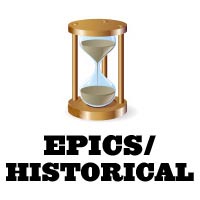 Epics-Historical Films often take an historical
or imagined event, mythic, legendary, or heroic figure, and add an extravagant
setting and lavish costumes, accompanied by grandeur and spectacle and a sweeping
musical score. Epics, costume dramas, historical dramas, war film epics, medieval romps, or 'period
pictures' are tales that often cover a large expanse of time set against a
vast, panoramic backdrop. In an episodic manner, they follow the continuing
adventures of the hero(s), who are presented in the context of great historical
events of the past. See also AFI's 10 Top 10 - The Top 10 Epic Films Epics-Historical Films often take an historical
or imagined event, mythic, legendary, or heroic figure, and add an extravagant
setting and lavish costumes, accompanied by grandeur and spectacle and a sweeping
musical score. Epics, costume dramas, historical dramas, war film epics, medieval romps, or 'period
pictures' are tales that often cover a large expanse of time set against a
vast, panoramic backdrop. In an episodic manner, they follow the continuing
adventures of the hero(s), who are presented in the context of great historical
events of the past. See also AFI's 10 Top 10 - The Top 10 Epic Films
Epics are historical films that recreate past events. They
are expensive and lavish to produce, because they require elaborate and panoramic
settings, on-location filming, authentic period costumes, inflated action
on a massive scale and large casts of characters. Biopic
(biographical) films are often less lavish versions of the epic film.
Epics often rewrite history, suffering from inauthenticity,
fictitious recreations, excessive religiosity, hard-to-follow details and
characters, romantic dreamworlds, ostentatious vulgarity, political correctness,
and leaden scripts. Accuracy is sometimes sacrificed: the chronology is telescoped
or modified, and the political/historical forces take a back seat to the personalization
and ideological slant of the story (i.e., the 'poetic license' of Oliver Stone's
controversial JFK (1991) immediately comes to mind).
Epics often share elements of the more elaborate adventure films genre and swashbuckler subgenre (e.g., the Robin Hood tale of  The Adventures of Robin Hood (1938)). They may be combined with other
genre types too, including: The Adventures of Robin Hood (1938)). They may be combined with other
genre types too, including:
- epic/historical westerns (i.e., Cimarron (1930), Dances with Wolves (1990))
- epic science-fiction (i.e.,
 Star Wars (1977)) Star Wars (1977))
- epic/historical dramas (i.e., Bernardo Bertolucci's The Last Emperor (1987))
- epic war films (i.e., The Longest Day (1962))
- unconventional epics (i.e., Robert Altman's
 Nashville (1975)) Nashville (1975))
- auteur epics (i.e., Coppola's
 Apocalypse Now (1979), Warren Beatty's period film Reds (1981),
and theatrical director Julie Taymor's adaptation of Shakespeare's Titus
(1999) (Andronicus) - her debut film with innovative production design) Apocalypse Now (1979), Warren Beatty's period film Reds (1981),
and theatrical director Julie Taymor's adaptation of Shakespeare's Titus
(1999) (Andronicus) - her debut film with innovative production design)
Epics have existed since the earliest days of American cinema,
from D. W. Griffith's ground-breaking  The Birth of a Nation (1915), to Cecil B. DeMille's Joan the Woman
(1916), The Ten Commandments (1923) and The King of Kings (1927), to the giant Civil War epic and Best
Picture winner The Birth of a Nation (1915), to Cecil B. DeMille's Joan the Woman
(1916), The Ten Commandments (1923) and The King of Kings (1927), to the giant Civil War epic and Best
Picture winner  Gone With The Wind (1939), to the fairly-recent Gone With The Wind (1939), to the fairly-recent  Schindler's List (1993), Titanic (1997), and Ridley Scott's
revamped 'sword and sandal' epic Gladiator (2000). Irreverent spoofs
of Biblical films have also emerged, such as The Life of Brian (1979),
with the Monty Python cast. Schindler's List (1993), Titanic (1997), and Ridley Scott's
revamped 'sword and sandal' epic Gladiator (2000). Irreverent spoofs
of Biblical films have also emerged, such as The Life of Brian (1979),
with the Monty Python cast.
Epics are often called costume dramas, since they
emphasize the trappings of a period setting: historical pageantry, costuming
and wardrobes, locale, spectacle, decor and a sweeping visual style. They
often transport viewers to other worlds or eras: ancient times, biblical times,
the Middle Ages, the Victorian era, or turn-of-the-century America. Unlike
true historical epics, period films choose a specific historical period,
and then superimpose fictional characters or events into the setting.
Two of the Earliest Epics from Italy: Quo Vadis? and Cabiria
Along with Enrico Guazzoni's epic Quo Vadis? (1912,
It.) - often considered the first successful feature-length motion
picture and one of the first films with over two hours running time, the influential
three-hour Italian silent film from Giovanni Pastrone, Cabiria (1914, It.), was an early example of spectacular and monumental epic film-making. It laid
the pattern and groundwork for future big-budget feature-length films (by
the likes of D.W. Griffith - for his Judith of Bethulia (1914),  The Birth of a Nation (1915), and later his Babylonian sequences
in The Birth of a Nation (1915), and later his Babylonian sequences
in  Intolerance (1916) - and Cecil B. DeMille). Its story of 3rd century
BC Ancient Rome included sequences of the eruption of Mt. Etna and Hannibal's
crossing of the Alps with elephants (with an early example of tracking shots).
The landmark film was shot on location in North Africa, Sicily and the Italian
Alps. It was also the first film to be screened at the White House. Intolerance (1916) - and Cecil B. DeMille). Its story of 3rd century
BC Ancient Rome included sequences of the eruption of Mt. Etna and Hannibal's
crossing of the Alps with elephants (with an early example of tracking shots).
The landmark film was shot on location in North Africa, Sicily and the Italian
Alps. It was also the first film to be screened at the White House.
Silent Epics of D. W. Griffith:
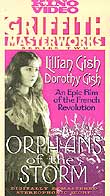 The
first great category of cinematic epics are the silent epics. The first
American epic was early cinematic pioneer D. W. Griffith's Biblical spectacle Judith of Bethulia (1914), a little known four-reel feature film weaving
together two Apocryphal stories about the 40-day Assyrian siege of the walled
Judean city of Bethulia. Griffith's most influential and complex film, noted
for its technical virtuosity and dynamic editing (although controversial for
its southern point of view) was the first blockbuster film The
first great category of cinematic epics are the silent epics. The first
American epic was early cinematic pioneer D. W. Griffith's Biblical spectacle Judith of Bethulia (1914), a little known four-reel feature film weaving
together two Apocryphal stories about the 40-day Assyrian siege of the walled
Judean city of Bethulia. Griffith's most influential and complex film, noted
for its technical virtuosity and dynamic editing (although controversial for
its southern point of view) was the first blockbuster film  The Birth
of a Nation (1915). It reproduced the Civil War and Reconstruction
Periods (including various battles, Lincoln's assassination, and the aftermath)
and told of the war's effects upon two families (the Northern Stonemans and
the Southern Camerons) with a specific ideological slant that distorted its
historical veracity. This almost three-hour film's screenplay was based upon
Thomas Dixon's novel and play The Clansman. The Birth
of a Nation (1915). It reproduced the Civil War and Reconstruction
Periods (including various battles, Lincoln's assassination, and the aftermath)
and told of the war's effects upon two families (the Northern Stonemans and
the Southern Camerons) with a specific ideological slant that distorted its
historical veracity. This almost three-hour film's screenplay was based upon
Thomas Dixon's novel and play The Clansman.
The next Griffith film was another silent epic:  Intolerance (1916), that studied the effects of injustice and intolerance
in four separate yet inter-connected and parallel stories in different time
periods (its Babylonian sequence with massive sets is still remarkable). Its
theme of "Love's struggle throughout the ages" and its passionate
plea for tolerance was a response to his Birth of a Nation critics.
Griffith's Orphans of the Storm (1921) was set against the backdrop
of pre-Revolutionary France, and followed the paths of two sisters (the Gish
sisters) who were separated and raised in different environments - one by
aristocratic nobles, the other by thieving peasants. Intolerance (1916), that studied the effects of injustice and intolerance
in four separate yet inter-connected and parallel stories in different time
periods (its Babylonian sequence with massive sets is still remarkable). Its
theme of "Love's struggle throughout the ages" and its passionate
plea for tolerance was a response to his Birth of a Nation critics.
Griffith's Orphans of the Storm (1921) was set against the backdrop
of pre-Revolutionary France, and followed the paths of two sisters (the Gish
sisters) who were separated and raised in different environments - one by
aristocratic nobles, the other by thieving peasants.
Silent Epics of Cecil B. De Mille: The Biblical
Epic Subgenre
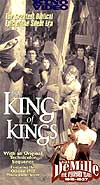 Griffith's
directorial counterpart, who specialized in extravagant epics throughout his
entire career spanning both the silent and sound eras, was film showman Cecil
B. De Mille. In reaction to Griffith's epic Intolerance (1916), Cecil B. DeMille (still at Famous Players-Lasky Corp., soon to be Paramount) went on to make his first large scale spectacle/epic film titled Joan the Woman (1916), one of the first epic biopics. It was DeMille's version of the Joan of Arc story starring opera star Geraldine Farrar and Wallace Reid. Its release coincided with the US entry into The Great War (and echoed the raging conflict), and the film served as propaganda for the Allies, with its framing story set in the English trenches of World War I. The film received critical acclaim and was greeted with modest box-office success. Griffith's
directorial counterpart, who specialized in extravagant epics throughout his
entire career spanning both the silent and sound eras, was film showman Cecil
B. De Mille. In reaction to Griffith's epic Intolerance (1916), Cecil B. DeMille (still at Famous Players-Lasky Corp., soon to be Paramount) went on to make his first large scale spectacle/epic film titled Joan the Woman (1916), one of the first epic biopics. It was DeMille's version of the Joan of Arc story starring opera star Geraldine Farrar and Wallace Reid. Its release coincided with the US entry into The Great War (and echoed the raging conflict), and the film served as propaganda for the Allies, with its framing story set in the English trenches of World War I. The film received critical acclaim and was greeted with modest box-office success.
De Mille continued during his early film career with a series of silent
Biblical or religious epics - a specific subgenre. These 'swords-and-sandals'
films, with a strong religious viewpoint, were set during Roman times in the
ancient world, and were noted for casts of thousands in crowd scenes. His two-part silent version of The Ten Commandments (1923) included spectacular special effects for the parting of the Red Sea. This
film foreshadowed the advent of future De Mille spectacles. He followed The
Ten Commandments with King of Kings (1927), a beautifully-lavish
yet reverential story of the life of Christ with a climactic resurrection
scene (in color) and ascension. [King of Kings was re-released in 1931
with a synchronized musical score.]
Other Silent Era Epics:
 Director
Fred Niblo spent millions and two years to create the most expensive film
of its time - MGM's silent-era Ben-Hur: A Tale of the Christ (1926),
that starred Ramon Novarro and Francis Bushman as rivals Ben-Hur and Messala,
respectively. The film included two colossal sequences: the sea galley battle
with pirates and the famous chariot-race. Rex Ingram's anti-war film The
Four Horsemen of the Apocalypse (1921), a star-making vehicle for Rudolph
Valentino, was about two Argentinian brothers who ended up fighting on different
sides in WWI. A non-Biblical epic of the silent era was Erich Von Stroheim's
monumental masterpiece titled Director
Fred Niblo spent millions and two years to create the most expensive film
of its time - MGM's silent-era Ben-Hur: A Tale of the Christ (1926),
that starred Ramon Novarro and Francis Bushman as rivals Ben-Hur and Messala,
respectively. The film included two colossal sequences: the sea galley battle
with pirates and the famous chariot-race. Rex Ingram's anti-war film The
Four Horsemen of the Apocalypse (1921), a star-making vehicle for Rudolph
Valentino, was about two Argentinian brothers who ended up fighting on different
sides in WWI. A non-Biblical epic of the silent era was Erich Von Stroheim's
monumental masterpiece titled  Greed (1924), a severely-edited tale about the corruptive influences
of avarice on a San Francisco dentist, his wife and an associate. Greed (1924), a severely-edited tale about the corruptive influences
of avarice on a San Francisco dentist, his wife and an associate.
Raoul Walsh's imaginative Arabian Nights fantasy The
Thief of Bagdad (1924) starred Douglas Fairbanks, Sr.
with magical special effects and lavish production values including
a flying carpet. King Vidor's epic war film The
Big Parade (1925) told the heart-wrenching tale of the
love between a French peasant girl and an American doughboy fighting
WWI in Europe. Russian director Sergei Eisenstein's silent masterpiece The
Battleship Potemkin (1925) portrayed the 1905 revolution through
a microcosmic view of a mutinous uprising aboard a Russian battleship.
Its pioneering montage/editing sequences in the bloody Odessa
Steps sequence changed filmmaking forever.
MGM - Epic Maker:
In the mid-1930s, MGM won the Best Picture with its adapted
version of Charles Nordhoff's and James Norman Hall's historical non-fiction
novel, the sea-adventure epic Mutiny on the Bounty
(1935). It featured on-location shooting in Tahiti, and Charles Laughton
as the definitive Captain Bligh and Clark Gable as Fletcher Christian (both
nominated for Best Actor, along with co-star Franchot Tone). It was MGM's
most expensive film production since their Ben-Hur: A Tale of the Christ
(1926), at $2 million. [An inferior remake, Mutiny on the Bounty (1962),
starred Marlon Brando as Fletcher Christian.] Soon after, MGM produced the
epic The Good Earth (1937), the last film of legendary producer Irving
Thalberg - it was also an adaptation - of the Pearl S. Buck novel about Chinese
peasants who faced, among other things, a devastating locust plague.
During the 40s, epics didn't fare very well, due to the scarcity
of the war years. One exception was the British Shakespearean film from Laurence
Olivier, Henry V (1944), with an American release in 1946. Best Picture
and Best Actor-nominated Olivier won a special Academy Award for "his
outstanding achievement as actor, producer and director in bringing Henry
V to the screen."
Cecil B. De Mille's Biblical and Roman Empire Epics of
the Sound Era:
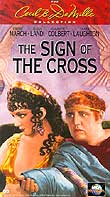 Beginning
around the mid-1930s, De Mille's The Sign of the Cross (1932) featured
Charles Laughton as a depraved Emperor Nero, Christians being consumed by
lions in the arena, Roman orgies, and Claudette Colbert as the Emperor's wife
in a bathing scene. In the following year, his version of Cleopatra
(1934) featured Claudette Colbert again as the temptress Queen of
Egypt. After a long hiatus, the famous director returned to his Biblical epic
format with the first major post-war epic derived from the Book of Judges
in the Old Testament - Paramount's extravagant spectacle Samson and Delilah
(1949). It starred ravishing Hedy Lamarr as the vixenish, vindictive Philistine
woman who seduced long-haired Danite strongman Victor Mature. In the most
spectacular scenes, Samson fought with a lion, destroyed an army with the
jawbone of an ass, and brought down the Temple of Gaza. [Two
others with dual-character titles also appeared during the era: Henry King's David and Bathsheba (1951) with a miscast Gregory Peck and Susan Hayward,
and King Vidor's expensive Solomon and Sheba (1959) with Yul Brynner
(replacing the deceased Tyrone Power who passed away during filming) and Gina
Lollobrigida.] Beginning
around the mid-1930s, De Mille's The Sign of the Cross (1932) featured
Charles Laughton as a depraved Emperor Nero, Christians being consumed by
lions in the arena, Roman orgies, and Claudette Colbert as the Emperor's wife
in a bathing scene. In the following year, his version of Cleopatra
(1934) featured Claudette Colbert again as the temptress Queen of
Egypt. After a long hiatus, the famous director returned to his Biblical epic
format with the first major post-war epic derived from the Book of Judges
in the Old Testament - Paramount's extravagant spectacle Samson and Delilah
(1949). It starred ravishing Hedy Lamarr as the vixenish, vindictive Philistine
woman who seduced long-haired Danite strongman Victor Mature. In the most
spectacular scenes, Samson fought with a lion, destroyed an army with the
jawbone of an ass, and brought down the Temple of Gaza. [Two
others with dual-character titles also appeared during the era: Henry King's David and Bathsheba (1951) with a miscast Gregory Peck and Susan Hayward,
and King Vidor's expensive Solomon and Sheba (1959) with Yul Brynner
(replacing the deceased Tyrone Power who passed away during filming) and Gina
Lollobrigida.]
Showman De Mille reshot his own silent era 1923 film in the
mid-1950s in the wide-screen Technicolor format on a grander scale. His 70th
(and final film), The Ten Commandments (1956) starred actor Charlton Heston as the Hebrew leader Moses, performing special
effects plagues before Yul Brynner as the Pharoah Rameses, and parting the
Red Sea for the Israelites. The film's sole Oscar win was for its special
effects. [In the same year, producer Michael Todd's epic travelogue presentation
of Jules Verne's 1872 novel Around the World in 80 Days (1956) won
Best Picture.]
Other 50s and 60s Grand-Scale Biblical and 'Sword and Sandal'
Epics:
In the 50s, the sound era brought more Biblical, historical,
or Grecian/Roman times epics, alongside the development of colorful wide-screen
CinemaScope to lure viewers away from their home televisions with free programming.
Mervyn LeRoy's and MGM's full-scale, big-budget Quo Vadis? (1951) with
Robert Taylor and Deborah Kerr, told the tale of Emperor Nero's (Peter Ustinov)
times and Christian persecution, and included great spectacle, costumes, romance,
and action. Using sets left-over from Quo Vadis? (1951), MGM followed
with Joseph L. Mankiewicz's hit Julius Caesar (1953), a star-studded,
faithful Shakespearean adaptation with James Mason, John Gielgud, Louis Calhern
(as Julius Caesar) and Marlon Brando (as Marc Antony). In the same year, Columbia
produced the opulent, non-widescreen historical/religious epic Salome (1953) with Rita Hayworth as the title character Princess and Charles Laughton as
King Herod.
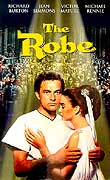 Director
Henry Koster's and 20th Century Fox's The Robe (1953) was the first widescreen
CinemaScope feature film. The landmark film starred Richard Burton
as young Roman tribune Marcellus Gallio whose life was affected by
Jesus' robe, Victor Mature as his converted slave Demetrius, and
Jean Simmons as Diana. Its success spurred the development of a sequel
of sorts, Delmer Daves' Demetrius and the Gladiators (1954),
again with Victor Mature and also Susan Hayward. Mature, one of the
mainstays of the ancient epic, also starred in Fox's intelligent
film about 14th century BC Egypt in the same year - The
Egyptian (1954), with supporting roles from Gene Tierney, Jean
Simmons, and Peter Ustinov. It also included a score from Alfred Newman
and Bernard Herrmann. Douglas Sirk's first Cinemascope
film was the uncharacteristic 'sword and sandal' historical costume
adventure The
Sign of the Pagan (1954). It starred Jeff
Chandler as a Roman centurion battling the forces of long-haired
Attila the Hun (Jack Palance!) with a Fu Manchu mustache. Director
Henry Koster's and 20th Century Fox's The Robe (1953) was the first widescreen
CinemaScope feature film. The landmark film starred Richard Burton
as young Roman tribune Marcellus Gallio whose life was affected by
Jesus' robe, Victor Mature as his converted slave Demetrius, and
Jean Simmons as Diana. Its success spurred the development of a sequel
of sorts, Delmer Daves' Demetrius and the Gladiators (1954),
again with Victor Mature and also Susan Hayward. Mature, one of the
mainstays of the ancient epic, also starred in Fox's intelligent
film about 14th century BC Egypt in the same year - The
Egyptian (1954), with supporting roles from Gene Tierney, Jean
Simmons, and Peter Ustinov. It also included a score from Alfred Newman
and Bernard Herrmann. Douglas Sirk's first Cinemascope
film was the uncharacteristic 'sword and sandal' historical costume
adventure The
Sign of the Pagan (1954). It starred Jeff
Chandler as a Roman centurion battling the forces of long-haired
Attila the Hun (Jack Palance!) with a Fu Manchu mustache.
Former
bodybuilder Steve Reeves starred as the mighty-muscle-bound Hercules,
the Greek mythological hero, in two films, Hercules (1958) -
a big hit when released internationally in 1959, and its rushed-into-production
sequel Hercules
Unchained (1959). [The series continued without Reeves and director
Pietro Francisci at the helm, in a number of Italian-made B-film
sequels and other muscle-man epics - the real 'sword and sandal'
films of the era.]
By the mid-50s and for the decade afterwards, many of these
kinds of epics were typecasting various players, such as Victor Mature, Charlton
Heston, Yul Brynner, Richard Burton, Jean Simmons, Peter Ustinov, and Stephen
Boyd. Richard Burton starred as the title character in writer-director-producer
Robert Rossen's Cinemascopic epic Alexander the Great (1956). [Other
epic films about Alexander the Great, directed by Oliver Stone and Baz Luhrmann,
are to be released in 2004 and 2005 respectively.]
William Wyler's and MGM's beautifully framed, eleven Oscar-winning
blockbuster film  Ben-Hur (1959), derived from Major General Lew Wallace's A Tale
of the Christ, was a remake of the earlier classic silent film of the
same title with Ramon Novarro and Francis X. Bushman. This newer version,
a $15 million three and a half-hour remake, starred Charlton Heston as the
title character, and Stephen Boyd as his childhood friend/Roman enemy Messala,
and included the same exciting slave galley battle scene and memorable chariot
race. Ben-Hur (1959), derived from Major General Lew Wallace's A Tale
of the Christ, was a remake of the earlier classic silent film of the
same title with Ramon Novarro and Francis X. Bushman. This newer version,
a $15 million three and a half-hour remake, starred Charlton Heston as the
title character, and Stephen Boyd as his childhood friend/Roman enemy Messala,
and included the same exciting slave galley battle scene and memorable chariot
race.
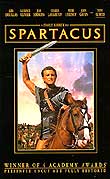 The
1960s opened with Stanley Kubrick's intelligent gladiator-revolt epic Spartacus
(1960) - the saga was based on Howard Fast's novel (with a script
by Fast and Dalton Trumbo, both blacklisted during the McCarthy 'witch
hunts') about an aborted Roman slave uprising in 73 B.C. Its original
director Anthony Mann was fired two weeks into production - the
opening shots of the film remain from his work. Spartacus was
the first film to list a black-listed
writer's name on the screen. The
1960s opened with Stanley Kubrick's intelligent gladiator-revolt epic Spartacus
(1960) - the saga was based on Howard Fast's novel (with a script
by Fast and Dalton Trumbo, both blacklisted during the McCarthy 'witch
hunts') about an aborted Roman slave uprising in 73 B.C. Its original
director Anthony Mann was fired two weeks into production - the
opening shots of the film remain from his work. Spartacus was
the first film to list a black-listed
writer's name on the screen.
Epic star Charlton Heston portrayed legendary 11th-century
medieval Spanish hero/warrior Rodrigo Diaz de Bivar (El Cid) who united the
Moors and Christians under one King, with Sophia Loren in Anthony Mann's spectacular
and handsome-looking El Cid (1961), an adaptation from French playwright
Pierre Corneille's work. Nicholas Ray reprised the intelligently-told King
of Kings (1961), another tale of the life of Christ starring Jeffrey Hunter
and narrated by Orson Welles. Dino De Laurentis produced Barabbas (1962) which starred Anthony Quinn as the murderous thief who was haunted for life
after being freed by Pilate and exchanged for Jesus. Another Biblical epic,
director Robert Aldrich's Italian-made Sodom and Gomorrah (1962) depicted
the destruction of the two sinful cities with expensive production values.
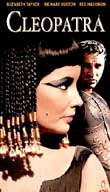 Joseph
L. Mankiewicz directed the all-star costly, opulent, four-hour version of
20th Century Fox's flop Cleopatra (1963) starring Elizabeth Taylor
as the provocatively-costumed Egyptian Queen, Richard Burton (in his best
epic appearance) as Marc Antony, and Rex Harrison as Julius Caesar. Taking
five years to prepare and 10 months to shoot on a budget that grew to $44
million, the film nearly bankrupted Fox Studios. Taylor became the first star to be paid $1 million for this role. Joseph
L. Mankiewicz directed the all-star costly, opulent, four-hour version of
20th Century Fox's flop Cleopatra (1963) starring Elizabeth Taylor
as the provocatively-costumed Egyptian Queen, Richard Burton (in his best
epic appearance) as Marc Antony, and Rex Harrison as Julius Caesar. Taking
five years to prepare and 10 months to shoot on a budget that grew to $44
million, the film nearly bankrupted Fox Studios. Taylor became the first star to be paid $1 million for this role.
Anthony Mann's big-budget historical epic The Fall of the
Roman Empire (1964) with Stephen Boyd chronicled events in ancient Rome.
And George Stevens' The Greatest Story Ever Told (1965) featured many
Hollywood and international stars in unexpected roles - including Charlton
Heston as John the Baptist and Max Von Sydow as Jesus. Director John Huston's
epic three-hour The Bible (1966) was a misnomer when all the other
directors in producer Dino De Laurentiis' extensive project bowed out. [A
subtitle was added to the film's title, making it The Bible: In the Beginning,
referring to the fact that only the first 22 chapters of Genesis were included,
with the story of Creation, Adam and Eve in the Garden of Eden, Cain and Abel,
Noah's Ark and the flood (with Huston as Noah himself), and the patriarchal
story of Abraham and Sarah.]
Biographical (Biopics):
Another subgenre of epics are 'biopics'
or biographical works, that dramatize the life of an actual historical
figure (usually a 'Great Man', politician or President, entertainer, inventor/scientist,
military leader, artist, sports hero or celebrity). Genre hybrids are common
in this sub-genre. In many cases, these films put an emphasis on the larger
events (wartime, political or social conditions) surrounding the person's
entire life as they rise to fame and glory.
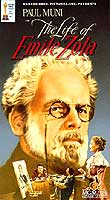 A
few examples in early film history include: two award-winning, Warner Bros.
historical/biographical films, both starring Paul Muni - William Dieterle's The Story of Louis Pasteur (1936) about the famous French scientist,
and the fictionalized Best Picture-winning The Life of Emile Zola (1937) about the famous French writer and court defender. Other examples include
Norman Taurog's children's dramatic film Young Tom Edison (1940) about
the famed inventor (Mickey Rooney), the historical drama Marie Antoinette
(1938), about the famous Austrian princess who married future King Louis
XVI, John Ford's quasi-biography Young Mr. Lincoln (1939) with Henry
Fonda in the title role, and Raymond Massey in an adaptation of Robert Sherwood's
Pulitzer Prize winning play, Abe Lincoln in Illinois (1940). Although
the film traces the career of a fictional newspaper tycoon (patterned after
William Randolph Hearst), A
few examples in early film history include: two award-winning, Warner Bros.
historical/biographical films, both starring Paul Muni - William Dieterle's The Story of Louis Pasteur (1936) about the famous French scientist,
and the fictionalized Best Picture-winning The Life of Emile Zola (1937) about the famous French writer and court defender. Other examples include
Norman Taurog's children's dramatic film Young Tom Edison (1940) about
the famed inventor (Mickey Rooney), the historical drama Marie Antoinette
(1938), about the famous Austrian princess who married future King Louis
XVI, John Ford's quasi-biography Young Mr. Lincoln (1939) with Henry
Fonda in the title role, and Raymond Massey in an adaptation of Robert Sherwood's
Pulitzer Prize winning play, Abe Lincoln in Illinois (1940). Although
the film traces the career of a fictional newspaper tycoon (patterned after
William Randolph Hearst),  Citizen Kane (1941) can be considered a life-story 'biopic.' Henry
King's historical/political drama Wilson (1944) immortalized the life
story of WWI's US President Woodrow Wilson, much like the film biography of
Franklin Delano Roosevelt's life in Sunrise at Campobello (1960). Citizen Kane (1941) can be considered a life-story 'biopic.' Henry
King's historical/political drama Wilson (1944) immortalized the life
story of WWI's US President Woodrow Wilson, much like the film biography of
Franklin Delano Roosevelt's life in Sunrise at Campobello (1960).
Artists and literary authors have also inspired biographical
film epics, such as two films from Vincente Minnelli. His film Madame Bovary
(1949) starred James Mason as Gustave Flaubert on whose classic novel
the film was based, and another film, Lust for Life (1956) featured
Kirk Douglas as tormented Dutch painter Vincent Van Gogh. Also, Billy Wilder's The Spirit of St. Louis (1957) dramatized the historical figure of
27 year old Charles Lindbergh (James Stewart), the "Lone Eagle."
(Also see the dramas genre for sports
biopics).
More recent examples of biographical epics include the following
films:
- George C. Scott's unforgettable portrayal of the cantankerous
WWII general in the highly-regarded Patton (1970)
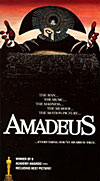 Sir
Richard Attenborough's $22 million production of Gandhi (1982) featured
Oscar-winning Ben Kingsley as the saintly 20th century Indian Mahatma -
pacifist and spiritual leader Sir
Richard Attenborough's $22 million production of Gandhi (1982) featured
Oscar-winning Ben Kingsley as the saintly 20th century Indian Mahatma -
pacifist and spiritual leader - the multiple award-winning film adaptation of the musical
Broadway hit Amadeus (1984), from director Milos Forman, viewed the
antics of young musical prodigy Mozart (Tom Hulce) [In its year of winning
the Oscar competition, it was running against two other big pictures: David
Lean's A Passage to India (1984) and The Killing
Fields (1984)]
- Bernardo Bertolucci's honored epic of the Chinese Ching
Dynasty and the life of Pu Yi, China's last emperor in the Best Picture-winning The Last Emperor (1987)
- Oliver Stone's Nixon (1995) with Anthony Hopkins
as the scandalous 37th President of the US and Joan Allen as his supportive,
long-suffering wife Pat
- writer/director Spike Lee's epic film Malcolm X (1992) told the life story of the slain civil rights leader with a great performance
from Denzel Washington
- Attenborough's reverential Chaplin (1992) chronicled
the life story of silent comedian and film-maker Charlie Chaplin (Robert
Downey, Jr.)
- Tim Burton's Ed Wood (1995) was about the maverick,
low-budget, Hollywood director (Johnny Depp) of cult films
- Alan Parker's musical biography Evita (1996) showcased
Madonna playing the role of beloved Argentinian Eva Peron
|
